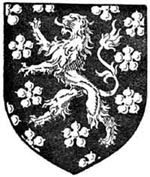< Introduction | Contents | Clifton (contd.) >
St Mary's, Clifton.
 Clifton tomb.
Clifton tomb. ARMS OF CLIFTON—Sable, semee of cinquefoils
argent, a lion rampant of the last.
ARMS OF CLIFTON—Sable, semee of cinquefoils
argent, a lion rampant of the last.THE north transept of this cruciform Church contains many monuments of the Cliftons, an old and now extinct Nottinghamshire "worthy family, which had their name from their residence here," the residence being situated on the steep south bank of the river Trent. This north transept was formerly known as the Chapel of the Holy Trinity, for in the Torre M.S. it is recorded that in the fifteenth century a Sir Robert Clifton (to whom is a fine brass on the floor) gave instructions that he should be "buried against the sepulchre of his wife in St. Trinity Chapel within the Church." According to a pedigree given in Dr. Thoroton's Antiquities of Nottinghamshire, their descent is traced from Alvereus de Clifton, Kt., who is therein alleged to have acted as Guardian of Nottingham Castle in the days of William Peverel. Succeeding generations, in which the Christian names of Gervase and Robert seem to predominate, furnished many influential men, who took their part in the affairs of their country and their county. Dr. Thoroton devotes much space in his history to this family and was a close friend and, apparently, professional attendant to the first Baronet, who was thirteenth Baronet of England, created by King James I (1611). He was in Parliament and married no less than seven wives! The Baronetcy became dormant on the death of Sir Robert Juckes Clifton, Bart., on 30 May, 1869.
Among the monuments alluded to are two alabaster Altar Tombs under the north window of the transept, one of a knight and another of a lady. As there is no inscription on either tomb, their identification is a matter of conjecture, but the heraldic bearings testify that they were undoubtedly Cliftons. Both are beautiful effigies.
The Knight lies on an embattled tomb and his head rests upon his helmet, which is surmounted with the Clifton crest, viz., out of a ducal coronet or, a demi-peacock per pale argent and sable, the wings displayed and counter changed. He wears the camail, elaborately chased plate armour, with coudieres; on his jupon the Clifton arms are shown, viz., a lion rampant; a horizontal jewelled sword-belt, from which hangs what is apparently a seal; sollerets and rowelled spurs; his sword by his left side, and laminated gauntlets, a costume indicating a date in the latter part of the fourteenth or early fifteenth century. Possibly therefore the effigy may be that of Sir Johannes de Clifton, who was killed at Shrewsbury (1403), but J. T. Godfrey in his Nottinghamshire Churches (p. 53), supposes this tomb to be that of the Sir Gervase Clifton, who died in 1508; the wearing of the camail however points to a period at least a hundred years earlier. In the same book the Lady is said probably to be Alice, daughter of Thomas Nevill, of Rolleston, widow of Thomas (or Richard) Turland, who married a Sir Gervase Clifton, as his first-wife, in the fifteenth century. The escutcheons upon her tomb confirm this: They are four in number, viz., i. Clifton, ii. Clifton impaling Nevill, iii. Clifton, iv. Nevill. From her head, which is attired in frets of network and supported by angels on either side, hangs a veil; her dress is close fitting and the tight sleeves are continued to the base of the fingers, giving the appearance of mittens; a chain round her waist from which is suspended a pomander, at her feet is a lamb. These tombs measure 87 by 29 inches and 85 by 29 inches respectively.
Standing at right angles to the south side of the transept is a large and imposing alabaster Altar Tomb, measuring 90 by 61 inches and 40 inches high, to Sir Gervase Clifton, Kt., and his two wives, between whom he is represented lying. He died in 1587. He is clad in a complete suit of plate armour with taces and tuilles, below which may be seen a baguette of mail, sabbatons, a ruff round his neck, and a heavy double chain round his shoulders. His hands, on several of the fingers of which are large rings, are, as also those of his wives, in an attitude of devotion clasping a book. His head, on which the hair is elaborately curled, reposes upon his helmet, surmounted by his crest, and those of his wives are on cushions; a misericorde dagger at his right side, where also lie his gauntlets. He married Maria, daughter of Sir John Nevill, of Choate or Cheete, Yorks; and, secondly, Winifred, daughter and heir of William Thwaites, of Oulton, Suffolk. Both wives are represented with ruffs round their necks and wrists, with caps fitting close to their heads. The whole tomb is of richly coloured alabaster, but has suffered from being removed from the "South Quire or Cross Ile on the south side" where it was originally placed. It bears no trace of paint.
< Introduction | Contents | Clifton (contd.) >
